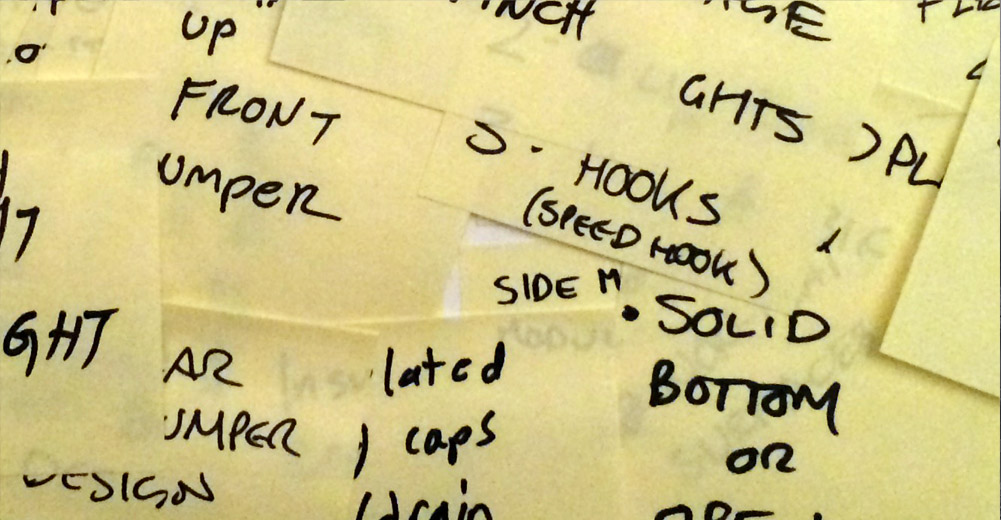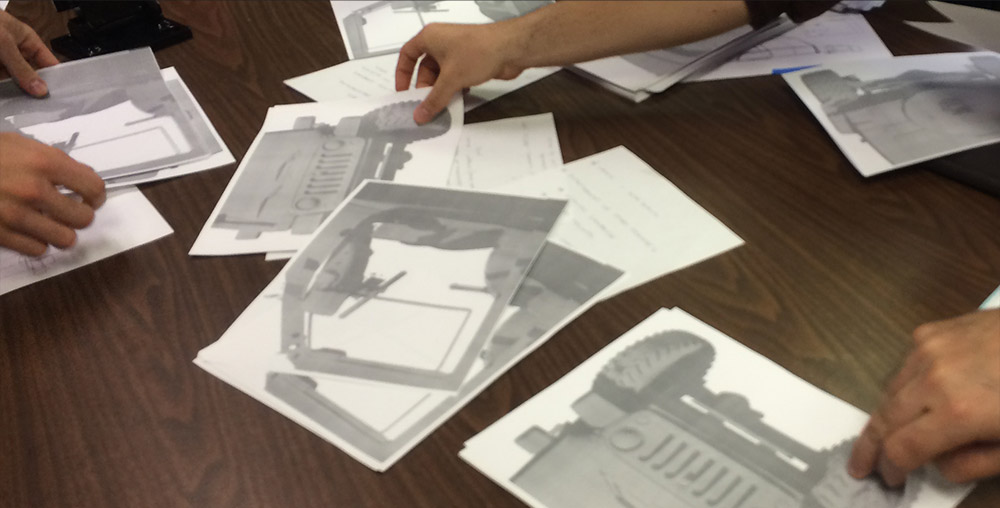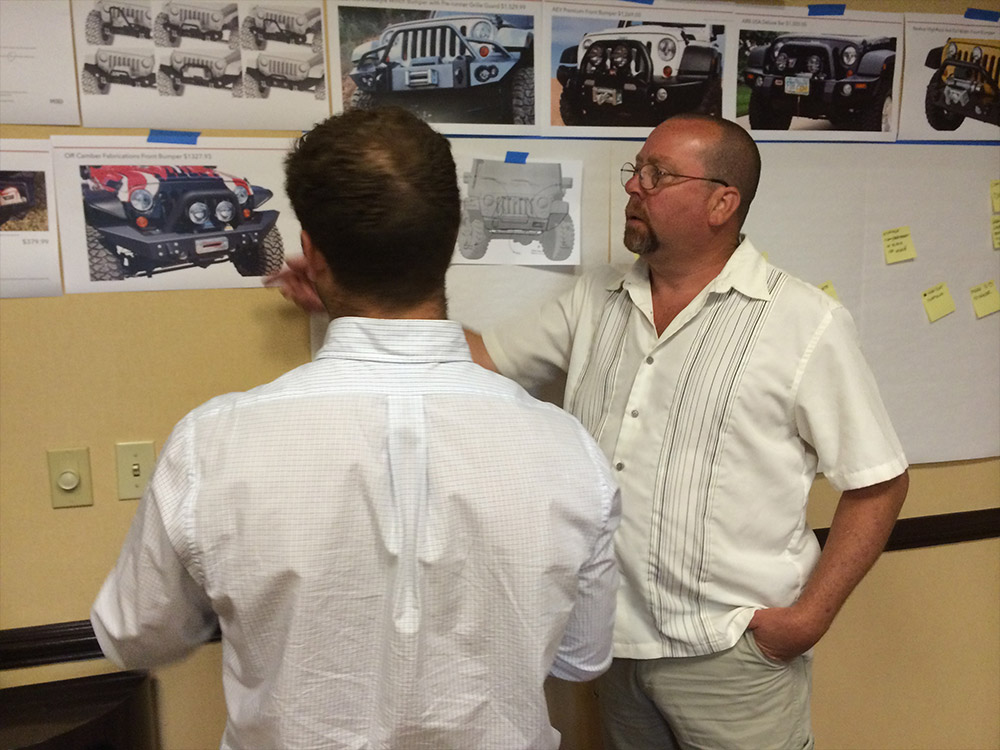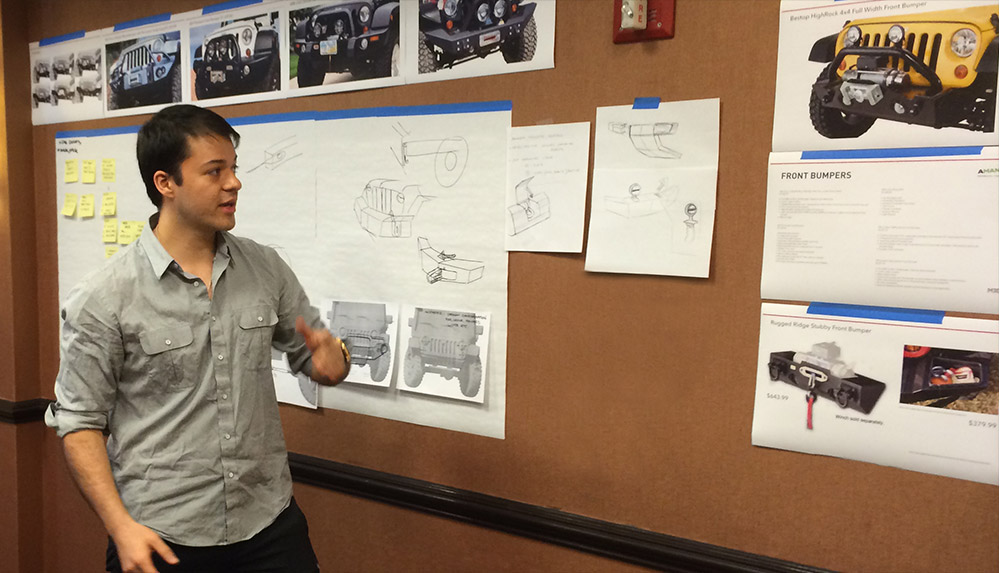IDEATION

Exploring the space between vision and reality
In June we met in the conference room of a Detroit area hotel. Meeting off-site would reduce day-to-day distractions and make it personal. Ideas would be shared in a spirit of creativity and cooperation. Instead of simply waiting for a chance to respond, participants were encouraged to listen closely and build on each others’ concepts. “No” and “Yes, but” were replaced with “Yes and….”
Lisa Lunsford was sick the first day of Ideation, but that didn’t prevent her from being involved. “Robert was talking, texting, sending me pics. He was saying ‘what if we did this?’ He’s open to things. That’s what makes our partnership work; we’re both open, willing to listen and try things. If something doesn’t work, we ask ‘what did we learn? What can we take from it and use someplace else?’ It’s great to have a partner like that.”
Two teams: twice the creativity
The group was divided into two equal teams based on skillset and personality type; then each team retreated to its own room with its own facilitator from M3D. All of the tables were pushed to the center so they’d have room at the walls. Research and competitive products were presented. Extreme vehicles were featured as inspiration and the designers were told to “Have at it! No limitations – be crazy, be creative. If you can design something that can be made through these means and materials, more power to you.”
Justin explained the process from his perspective. He said “The biggest thing I liked was Amanda Products didn’t really take the automotive approach, which is very competitive. From the beginning they took a product approach – got everybody together and did two full days of brainstorming, writing everything down on sticky notes and pasting on the wall.”

We taped images of well-known bumpers and doors to the wall. Everyone was given sticky notes, pens and sharpies so they could share ideas and comments. We printed out front, side and rear views of a Jeep Wrangler to draw on.

It's fun, give it a try; download the PDF here.
Download (79MB PDF)A large pad helped each team illustrate; manufacturers and engineers stepped up to draw how something might attach. Everyone stood all day; they were totally focused on what was happening on the wall.
Critiquing similar products
Jeep Wranglers are a blank canvas; they’re made to change. Outrageous vehicles served as proof that aftermarket accessories can enhance function while bringing an owner’s vision to life.
We reviewed doors first, then bumpers. Existing doors were fairly simple in design, ranging from skeletal to webbed military; their integration left room for creative solutions. We looked at the front bumpers on rock crawlers; some were brutish, others attempted a factory look. Rear bumpers were more of the same simplified.

As the teams began to formulate concepts, we told them the bumper had to be “the coolest bumper you’ve ever seen.”
– It has to be useful and durable
– Clearance was a consideration for rock crawling
– The quality has to be there; OE level quality
We asked them to consider product convenience, as in “if the bumper was your smart phone, what variations could you envision? What options?” With doors, the focus was on meaningful accessories. Usability was an underlying issue throughout. They stayed within the lines while doing some very cool work.
Creative tension intensified as ideas were shared. It’s the natural tension that occurs between vision and reality, between design and manufacture.
Ideas were met with openness and enthusiasm; no one backed away from participation. If someone mentioned engineering at that point, they were told “feasibility is not creativity’s friend.”
At the end of each product brainstorming session, Team A presented to Team B – and vice versa. Once we reviewed every idea on the tables, we took everything down from the walls, put it aside and reset the room for the next product.

At the end of the day we had two separate sets of ideas; we needed to drill down.
The following day we brought all of the people and ideas back to Amanda Products’ main conference room in Livonia. Matt Binkowski explained, “OK, we’re going to go back over everything for the same product from both teams at the same time.” Product by product, we spread them out over the table and asked “what lives – what dies – what makes this product say Amanda Products?” We captured all the opinions on one product before proceeding to the next.
Later in the day only the Design team remained. We examined what was left on the table and decided:
– Which concepts made sense
– Which designs looked best
– Which designer would further develop each product and its features
Creative tension returned as everyone realized you can’t have that many suggested features in one product. The designers were given the rest of the week for ‘incubation’ – time to work on their concepts and determine which were the most compelling or differentiating. On Friday we would regroup to discuss their design proposals for front bumpers, doors and rear bumpers.
Stage Two: DESIGN
![Amanda Products [USA] Logo](https://www.amandaproducts.com/wp-content/uploads/2017/04/aplogo_nonretina.png)